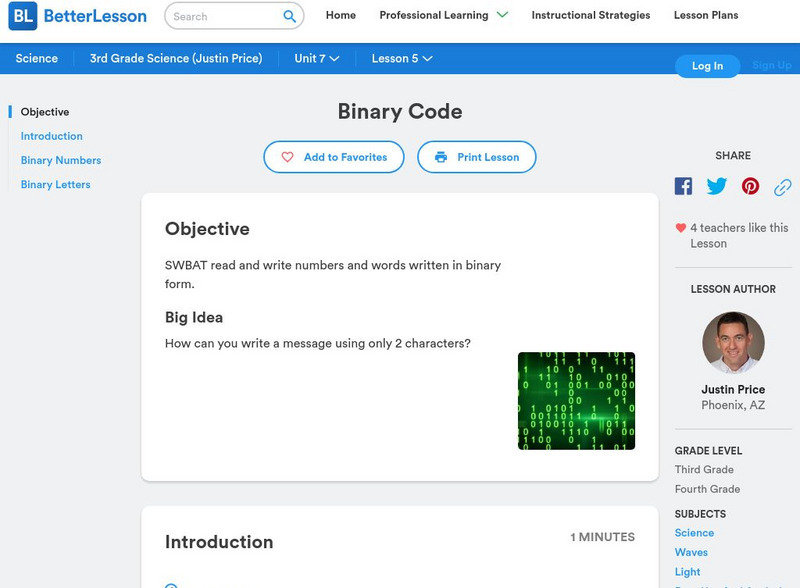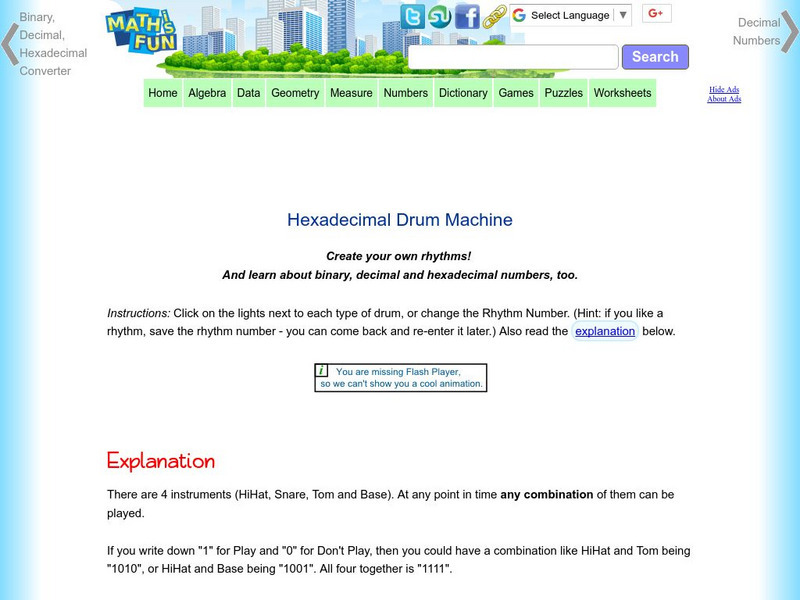Institute of Electrical and Electronics Engineers
Binary Basics
Back to the (binary) basics. The resource provides a simple overview of binary code and gives two different activities to introduce it to elementary and middle school learners. Classmates write and decode messages to each other in binary...
Code.org
Encoding Color Images
Color me green. The fourth lesson in a unit of 15 introduces the class to color images and how to encode color images using binary code and hexadecimal numbers — and they will quickly notice that it is easier to code the...
CK-12 Foundation
Values Written as Powers: Binary Numbers 9 to 16
Challenge mathematicians to crack the binary code with an interactive that focuses on numbers nine to 16. A table reveals exponential equations to aid in answering multiple-choice questions. A discussion question gauges comprehension.
CK-12 Foundation
Values Written as Powers: Binary Numbers 17 to 24
Boost mathematicians' proficiency of binary numbers 17 to 24 with an interactive comprised of six questions—multiple-choice, true or false, and a discussion. A color-coded table reveals binary equivalents to aid in the problem-solving...
Code.org
Processing Arrays
Scholars use a playing card activity to help them develop a program to find the minimum value of a list. They learn to use for loops to write code that will process lists.
Code.org
Practice PT - Encode an Experience
Encoding What I did Last Summer. Class members develop a way to encode a personal experience using a top-down approach to determine components and sub-components of their experience They then pick one portion of the experience and go...
TED Talks
Ted: Ted Ed: How Exactly Does Binary Code Work?
Every time you use the Internet to watch a movie, listen to music, or check directions, that's exactly what your device is doing, using the language of binary code.
Better Lesson
Better Lesson: Binary Code
Students will learn how to write numbers and words in binary form in order to understand that patterns can be used to transfer information. Resources include a video explanation and examples of student work.
Math Is Fun
Math Is Fun: Binary Digits
Learn about the two binary digits, 0 and 1, and how they are combined to make numbers that correspond to our standard number system. Looks also at the relationship between binary and hexadecimal digits.
Math Is Fun
Math Is Fun: Binary Fingers!
Learn how to count in binary using just your fingers and how this skill can help you in arithmetic. Includes a set of practice questions.
Math Is Fun
Math Is Fun: Binary Number System
Learn all about the binary number system and how to count in binary. Includes a set of practice questions.
Khan Academy
Khan Academy: Binary Numbers
Practice converting between binary numbers and decimal numbers in this set of free practice questions designed for AP Computer Science Principles students.
Code.org
Code.org: Cs Fundamentals: Course C
Create programs with sequencing, loops, and events. Translate your initials into binary, investigate different problem-solving techniques, and learn how to respond to cyberbullying. At the end of the course, create your very own game or...
Math Is Fun
Math Is Fun: Hexadecimal Drum Machine
Create rhythms on this 4-instrument hexadecimal drum machine and see what your rhythms look like in the binary, decimal, and hexadecimal number systems.
Khan Academy
Khan Academy: Hexadecimal Numbers
Practice converting hexadecimal numbers to binary and decimal numbers, in this set of practice questions designed for AP Computer Science Principles students.
Khan Academy
Khan Academy: Logic Gates
Check your understanding of how AND/OR/NOT logic gates output 0 or 1 based on inputs.
Khan Academy
Khan Academy: Number Limits, Overflow, and Round Off
Check your understanding of number precision, overflow errors, and roundoff errors in computer programs.
Khan Academy
Khan Academy: Bitwise Operators
These practice questions will assess your knowledge of bitwise operators.

















